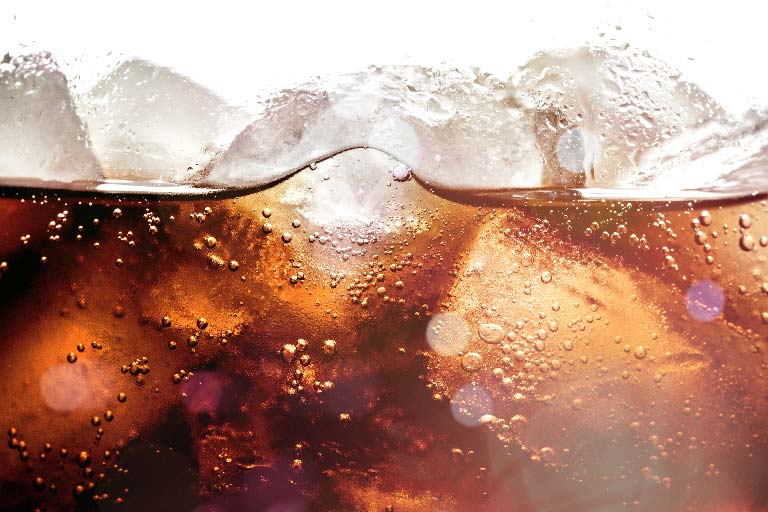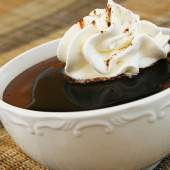Soft Drinks

Now that warmer weather is at long last (periodically) upon us, here is a relevant question: is there anything more refreshing than an ice-cold soft drink (or soda, or pop, or coke, or soda pop, or fizzy drink, depending upon where you hail from)?
A soft drink, essentially, is any non-alcoholic and dairy-free beverage — usually carbonated, but not always — that isn’t hot coffee or tea, or straight vegetable or fruit juice. Soft drinks are almost invariably made with sugar or artificial sweeteners, and we often hear about how unhealthy they are, but that certainly wasn’t how they were portrayed in the beginning. And soft drinks have been around for much longer than you might think…
…since 1676, to be exact, when the first soft drink manufacturer, Compagnie de Limonadiers, arrived on the beverage scene in Paris with their lemonade, made from lemon juice, water, and a small amount of honey. Their street vendors made a killing selling it by the cup to passersby (possibly the first recorded lemonade stand). It needed something, though…
Europeans had long prized mineral (spring) water for its detoxifying qualities, and its effervescent nature made it invigorating to drink, before flavorings were even added. Soon, someone managed to create artificially carbonated mineral water by injecting carbon dioxide into it, which made the soda fountain possible (one of the pioneers was Jacob Schweppe, whose name is still linked with soft drinks). By the early 1800s, ginger and lemon were being added to the mix.
The Women’s Christian Temperance Union (WCTU) came along in the United States in 1874 to rail against the evils of alcohol, so the time was ripe for a harmless alternative. Enter an Atlanta pharmacist, John S. Pemberton. In need of a distinctive soft drink for the soda fountain at his drugstore, Pemberton mixed up a flavored syrup inspired by wine that included extract of coca leaves (which are illegal now because they contain cocaine), sugar, and caffeine-infused kola nuts, among other mystery ingredients. Pemberton added carbonated water, sold it to patrons, and got an overwhelmingly positive response. (The highly addictive nature of the coca extract may have had something to do with it.) Pemberton’s bookkeeper, Frank Robinson, dubbed the beverage Coca-Cola and designed its iconic logo. The coca extract was phased out in 1903, and was banned altogether in 1914. Today, servings of Coca-Cola products worldwide clock in at about 1.9 billion annually.
Coca-Cola wasn’t the only soft drink to contain a mood-altering ingredient. The popular lemon-lime soda 7-Up was dreamed up in 1929 by St. Louis beverage entrepreneur Charles Leiper Grigg, and its original (and unwieldy) name was “Bib-Label Lithiated Lemon-Lime Soda.” Until 1948, it contained trace amounts of lithium citrate, which is used today in much higher dosages to treat bipolar disorder and depression. There is some disagreement about how it got its much catchier name in 1936, but the most likely story is that the “7” came from Lithium’s atomic mass. Speaking of mass, 7-Up was originally touted as “slenderizing,” but ironically, prolonged use of lithium can have the opposite effect. Also, at one time scientists contemplated adding lithium to our drinking water; happily for our waistlines and mental well-being, this idea was abandoned.
What about root beer? Various incarnations of it have been around since American colonial times — it is a part of a category called “small beers,” homemade brews that were made from barks, herbs, and roots (hence, the name) such as ginger, birch, and sarsaparilla — other additives might include sassafras, allspice, vanilla beans, licorice, and molasses, among many others. Some of these “small beers” were alcoholic; most were not. For commercial root beer, you can thank Charles Hires (another familiar name), a pharmacist who stumbled upon a great herbal tea recipe during his honeymoon. Back at the office, he formulated a dry mix for the tea, and later added carbonated water. Hires rolled out his invention at the Philadelphia Centennial exhibition in 1876. There is no set recipe for root beer; each manufacturer has his or her own.
A few other soft drink facts:
- If you use soft drinks as a mixer in cocktails, beware — you will become intoxicated about 20 percent faster if you use a diet beverage as opposed to the regular kind.
- If it seems as though soft drinks are “fizzier” in cans than in bottles, it’s because they are — carbon dioxide cannot escape from an aluminum can, but easily can from a bottle.
- After more than two decades at the top, in early 2013 the soft drink was supplanted by water as America’s most popular beverage, probably due to the known connection between soft drinks and obesity.
- The top 10 best-selling soft drinks in America are, in order: Coke, Diet Coke, Pepsi, Mountain Dew (invented as a mixer for whiskey — its name is slang for “moonshine”), Dr. Pepper, Sprite, Diet Pepsi, Diet Mountain Dew, Diet Dr. Pepper, and Fanta (various flavors).
- The Faygo soft drink company, whose flavors were initially inspired by cake frostings, may be the reason that the term “pop” became synonymous with soft drinks. They are credited with the first use of the twist-off cap, and the name comes from the “popping” sound the beverage makes when the bottle is opened.
So, as the Coke slogans have it, take “the pause that refreshes” — “catch the wave,” and enjoy the summer!





